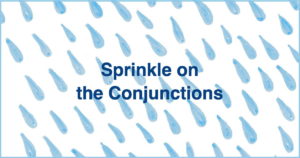
Although we seldom think about them, conjunctions are among the writer’s best friends. They make it clear what the relationship is between one action and another—and that’s what writing a story is all about, isn’t it? Unfolding events seen as cause and effect, not just random, unsequenced episodes.
“Conjunction” means a “joining together,” but that only tells a small part of the tale. For example, look at the conjunctions that appear in that first paragraph: although and and. And certainly joins together. But although is much more subtle and is almost impossible to define without using synonymous conjunctions. There is a sense of opposition there—we’ve taken something for granted which turns out to be important. Let’s look especially at the conjunctions that bind clauses, those complete sentence-like thoughts that represent an episode.
The conjunction you use makes a difference
There are lots of these li’l fellers, and each one unites the actions in a distinctive way, telling us the relationship between them. Some have slightly different grammatical uses, and some are always two part, but we’ll lump a few common ones together. (Talk to Grammar Girl for more precision.) Look at the difference it makes when you choose a conjunction:
- She was hungry, although she had eaten a big sandwich.
- She was hungry, and she had eaten a big sandwich.
- She was hungry, because she had eaten a big sandwich.
- She was hungry, but she had eaten a big sandwich.
- She was hungry, even though she had eaten a big sandwich.
- She was hungry, after she had eaten a big sandwich.She was hungry, before she had eaten a big sandwich.
- She was not only hungry, but she had also eaten a big sandwich.
- She was hungry, as if she had eaten a big sandwich.
Some of my poorly chosen examples don’t even make sense, because (!!) no such relationship exists between clause one and clause two. But you get the picture: the choice of conjunction can convey just the right transition between one action and another. And a big part of the successful texture of our writing has to do with transitions and relationships. Not to mention clarity and precision.
Smoothing it out
Without some complexification of sentences here and there, the texture of our writing is choppy. It may seem simple (perhaps simplistic), but in fact it’s harder to understand, because no relationships are inserted. Here’s where a conjunction or two can come in handy (and note how there are two of them in that sentence, explaining how the clauses hang together!). Consider this example of choppy writing, which isn’t even easy to understand:
The door opened. The man entered. The dog barked. The dog jumped around. The dog pulled at his chain. Everyone stood up. The man sat down. The people sat. The dog continued to bark. The man spoke. The people listened.
Are the actions sequential? Are any of them happening at the same time? Is any one action causal? Is any of it counter to expectation?
Now look at how much smoother and more meaningful the same scenario is—how much easier it is to form a mental picture—with the addition of a few conjunctions to guide the reader:
The door opened, and the man entered. Everyone stood up, while the dog barked and jumped around and pulled at his chain. When the man sat down, the people sat. Although the dog continued to bark, the man spoke, and the people listened.
These are words all English speakers understand, so there’s no mysterious calculus at work in choosing the right conjunction. Just don’t neglect to let them help you tell your story.

Arlene Miller, The Grammar Diva
Just an addition: The conjunctions that connect two complete sentences are called coordinating (for, and, nor, but, or, yet, so – FANBOYS). The conjunctions that connect a complete sentence with a dependent clause (although, because, until, etc.) are subordinating conjunctions. Generally, when the subordinating conjunction comes in the middle of the sentence, there is no comma before it (especially “because”).
Niki Kantzios
Oops! Leave it to the Grammar Diva to find my bad commas! Thanks, Adrienne. This is why we have proofreaders.
Lee Gramling
Some worthwhile points here, but frankly I tend to prefer the Hemingway style and trust my readers to make obvious connections. And I avoid complex sentences like the academic plague they frequently are. What’s more, as you can see, I decided long ago to ignore the “rule” that you can’t start a sentence with a conjunction.
Lynda Courtright
Thanks.
Niki Kantzios
I agree, Lee–rules are made to be broken. But Hemingway isn’t the only good writer. And I’m 100% with you on starting a sentence with a conjunction.